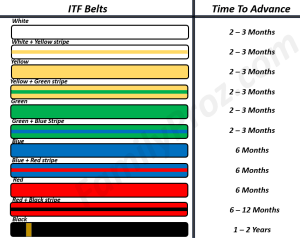
There are two main governing bodies for Taekwondo: The International Taekwon-Do Federation (ITF) and the World Taekwondo (WT, formerly known as the WTF). Each organization has its own ranking system however they share a lot of similarity within their Taekwondo belts.
Both systems use colored belts to represent geup (degree) ranks, the specific colors vary between organizations and from dojang to dojang. The ITF commonly uses white, yellow, green, blue, red, and black belts, whereas the WTF system often includes additional colors like orange and purple. We have covered the ATA Taekwondo Belt System separately.
Table of Contents
Toggle![]()
International Taekwondo Federation (ITF) Belts

ITF Taekwondo ranking system ranges from 10th Geup (white belt) to 1st dan (black belt). The Highest Dan achievable being the 10th Dan. The table below shows the ITF taekwondo belt ranks.
| Geup(Degree) | Belt Color | Time to Advance |
| 10th Geup | White Belt | 2-3 Months |
| 9th Geup | White Belt + Yellow stripe | 2-3 Months |
| 8th Geup | Yellow Belt | 2-3 Months |
| 7th Geup | Yellow Belt + Green stripe | 2-3 Months |
| 6th Geup | Green Belt | 2-3 Months |
| 5th Geup | Green Belt + Blue stripe | 2-3 Months |
| 4th Geup | Blue Belt | 6 Months |
| 3rd Geup | Blue Belt + Red stripe | 6 Months |
| 2nd Geup | Red Belt | 6 Months |
| 1st Geup | Red Belt + Black Stripe | 6 – 12 Months |
| 1st Dan | Black Belt | 1 – 2 Years |
World Taekwondo (WTF) Belts

WTF Taekwondo belt levels vary slightly as they omit striped belts and replace them with colors not found in the ITF system. The table below shows the WTF taekwondo belt ranks.
| Geup(Degree) | Belt Color | Time to Advance |
| 11th Geup | White Belt | 2-3 Months |
| 10th Geup | Yellow Belt | 2-3 Months |
| 9th Geup | Orange Belt | 2-3 Months |
| 8th Geup | Green Belt | 2-3 Months |
| 7th Geup | Purple Belt | 2-3 Months |
| 6th Geup | Blue Belt | 2-3 Months |
| 5th Geup | Blue SR. | 6 Months |
| 4th Geup | Brown Belt | 6 Months |
| 3rd Geup | Brown SR. | 6 Months |
| 2nd Geup | Red Belt | 6 Months |
| 1st Geup | Jr. Black | 6-12 Months |
| 1st Dan | Black Belt | 1-2 Years |
What belt can you start competing in Taekwondo?
The specific Taekwondo belt level at which you can start competing may vary depending on the rules and regulations of the governing organization or the tournament you wish to participate in. However, in most cases, practitioners are required to reach at least a Taekwondo Yellow Belt (8th Geup) before they are eligible to compete.
How Long Does it Take to Get Each Belt in Taekwondo?
Beginner Taekwondo belts regardless of the organisation awarding them usually take between 2-3 months to advance. Advancing between White, Yellow, and Green Belts takes on average 6 months (ITF), as each distinct color is separated by a stripped halfway belt. For Blue and Red belts the time required is doubled to a year and the final jump to a black belt takes between 1-2 years.
How Long Does It Take to Get a Black Belt in Taekwondo?
The minimum time spent training consistently to advance to a Black belt in Taekwondo is around 4 years. This assumes a practitioner trains 2+ times a week and consistently passes their gradings.
For a complete overview of what it takes to achieve a Taekwondo Black Belt check out our article.

![]()
How many belts in Taekwondo?
Following the ITF system there are 10 belts before a Black belt. The taekwondo belt order is as follows:
- White Belt
- White Belt with Yellow Stripe
- Yellow Belt
- Yellow Belt with Green Stripe
- Green Belt
- Green Belt with Blue Stripe
- Blue Belt
- Blue Belt with Red Stripe
- Red Belt
- Red Belt with Black Stripe
Whereas the WTF implements 11 belts before a Black belt. The taekwondo belt order is as follows:
- White Belt
- Yellow Belt
- Orange Belt
- Green Belt
- Purple Belt
- Blue Belt
- Blue Senior Belt
- Brown Belt
- Brown Senior Belt
- Red Belt
- Junior Black Belt
![]()
Highest Belt in Taekwondo

The highest belt rank in Taekwondo is the black belt (also known as 1st dan). After achieving the black belt, progression continues with higher degrees or dans. The dan system represents a person’s level of mastery and expertise in Taekwondo. The number of dan ranks can vary depending on the Taekwondo organization or school, but it commonly goes up to 9th dan. With the 10th dan black belt being awarded to just a few people.

Taekwondo Black Belt (Dans Progression)
| Dan (Phase) | Time to Advance |
| 1st Dan (Il Dan) | 1-2 Years |
| 2nd Dan (Ee Dan) | 2 Years |
| 3rd Dan (Sam Dan) | 4 Years |
| 4th Dan (Sa Dan) | 4 Years |
| 5th Dan (Oh Dan) | 6 Years |
| 6th Dan (Yook Dan) | 6 Years |
| 7th Dan (Chil Dan) | 8 Years |
| 8th Dan (Pal Dan) | 8+ Years |
| 9th Dan (Koo Dan) | 8+ Years |
![]()
Taekwondo belts meaning
The belt meaning in Taekwondo holds significance and represents a practitioner’s level of skill and knowledge. Each belt color signifies a stage of progression and growth in the martial art. As students advance through the ranks, they acquire new techniques, develop discipline, and deepen their understanding of Taekwondo’s principles. Belts serve as a visual representation of a practitioner’s dedication, perseverance, and commitment to their training.
White Belt – Taekwondo
![]()
Beginner Level – requires a few lessons to attain
A White belt represents a beginner or novice level of training and is the starting rank in all Taekwondo schools. It is the first step on a life long journey. Seen as a symbol of purity and a clean slate for the practitioner.
![]()
Yellow Belt – Taekwondo
![]()
Beginner Level
A Yellow belt in Taekwondo signifies progress and growth as it is the first rank advancement beyond the white belt level. The yellow color of the belt is a metaphor for a planted seed, representing the developing taekwondo foundation for a student.
![]()
Orange Belt – Taekwondo
![]()
Beginner Level
Orange is the rising sun which calls for the further growth of a student and of the planted seed representing their Taekwondo foundation.
![]()
Green Belt – Taekwondo
![]()
Intermediate Level – Requires 9-12+ months of training
A green belt represents an intermediate level of training. Portrays the growth of practitioners.
![]()
Purple Belt – Taekwondo
![]()
Intermediate Level
A purple belt in Taekwondo is a sign of a student approaching a fully developed Taekwondo foundation.
![]()
Blue Belt – Taekwondo
![]()
Intermediate Level
A blue belt in Taekwondo represents the sky which symbolizes the progress a student has made but also the journey still ahead of them.
![]()
Brown Belt – Taekwondo
![]()
Advanced Level – Requires 18-24+ months of training
Is a step into advanced levels of mastery in Taekwondo. Although not close to perfect or complete a students knowledge of taekwondo is vast.
![]()
Red Belt – Taekwondo
![]()
Advanced Level
A red belt in Taekwondo can be interpreted as an image of blood, warning others and the student of their proficiency in the martial art, it should serve as a reminder to exercise self control. Alternatively, the red belt is also viewed as a sunset which marks the ending of a students introduction to Taekwondo and the beginning of their mastery journey.
![]()
Black Belt – Taekwondo
![]()
Perceived as the epitome of Taekwondo by many but seen as another blank slate by others. From here on out students turn into leaders and further their skills to advance to higher black belt dans which take years to advance between each one.
![]()
Learn about other Martial Arts Belt systems in our articles on the:
![]()
FAQ
Is there a 10th degree black belt in Taekwondo?
Yes, there is a 10th degree black belt in Taekwondo. However, it’s important to note that the 10th degree black belt is an honorary rank and is typically reserved for the highest-ranking masters and founders of specific Taekwondo organizations or styles.
The 10th degree black belt is often seen as a symbolic rank that recognizes the immense contribution, knowledge, skill, and lifetime dedication of an individual to the art. It is a mark of exceptional mastery and leadership in the field.
It is noteworthy that individuals do not earn the 10th degree black belt through a standard progression, but instead, relevant organizations and governing bodies bestow this rank upon them.
What do the stripes on taekwondo belts mean?
Belt stripes recognize and signify progression within belt ranks. For instance, a student with a Green belt and blue stripe demonstrates advancement beyond Green and nears a full blue belt.
What are white belt stripes Taekwondo?
A Black belt with a white stripe is usually given to represent a Junior Black Belt rank (1st Geup) which is one grading away from a Black Belt (1st dan)



